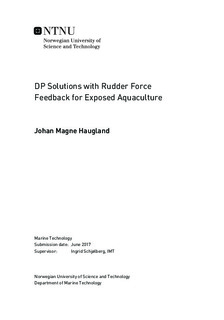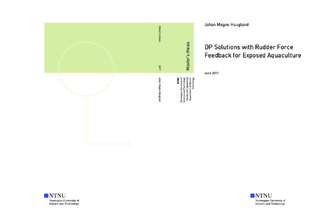| dc.description.abstract | Aquaculture and especially exposed aquaculture is a business heading into a period of large growth and rapid change. Considerable amounts of resources are and will be put into research to insure safe and sustainable operations at exposed locations, and for the business in general. A key factor is precise manoeuvrability of vessels operating at fish farms, both to avoid collision and in insuring minimal disturbance on the fish environment.
Thrust and manoeuvring devices are obviously a critical part of this process. The rudder is known for its efficiency in transit, though has shortcomings in terms of flexibility and low speed manoeuvring. Though the rudder may never be as precise as e.g. azimuth thrusters at DP operations, it might be able to compete on overall operational performance such as fuel consumption. However to avoid that the expenses of DP operation absorbs the gains of effective transit, we need to utilize the potential of the rudder to its maximum.
Thrust allocation schemes for effective use of rudders in DP is already developed in e.g. \cite{lindegaard2003}. When a rudder is exposed to incoming velocity it is able to produce sideways lift forces and longitudinal drag forces. With a twin propeller-rudder configuration one might utilize the lift forces to produce sum sideways forces. This can add to manoeuvrability, and in a best case scenario one might be able to comply with safety and performance standards with one less tunnel thruster.
An obstacle when utilizing rudders to produce sideways forces, is mathematical modelling. Precise modelling of rudder forces is challenging at steady state conditions, and to add further difficulties, rudder performance is known to change with varying external conditions. The main contribution of this thesis is the design and testing of a simple force feedback control system. The goal is to minimize the effect of deviations between the mathematical model of rudders in the control allocation, and the actual thruster output.
Through simulations we prove that the force feedback system is both power saving compared to not using rudders and has enhanced motion tracking compared to DP with rudders but without force feedback. Overall we conclude that it is absolutely possible that rudders are a part of the manoeuvring system which is most cost effective for well boats in aquaculture. Further work is however necessary. Relevant areas are e.g. control allocation, the effect of noisy force measurements on station keeping performance, time varying rudder dynamics, utilizing of force measurement in autopilots and life cycle cost analysis. | |

